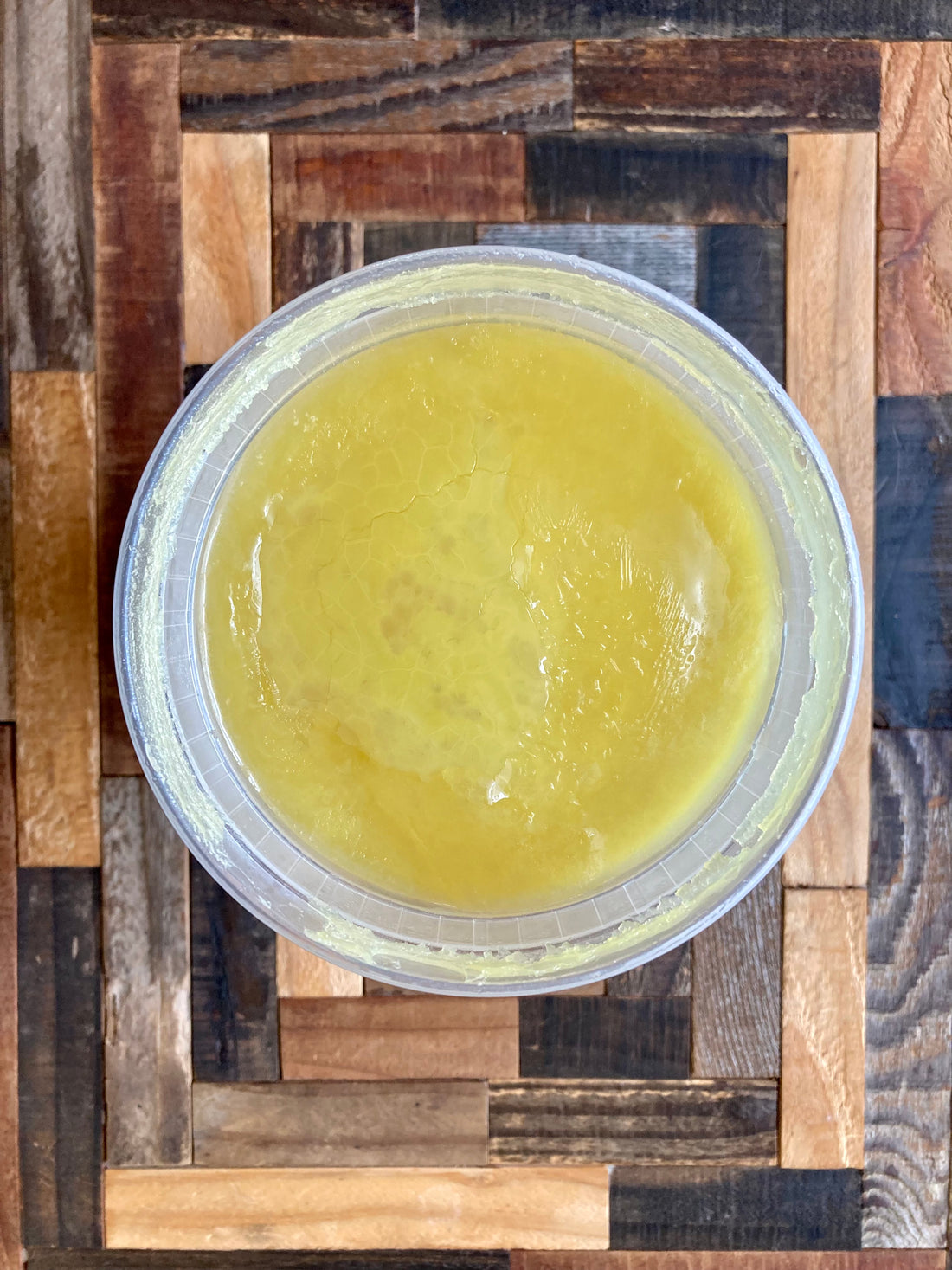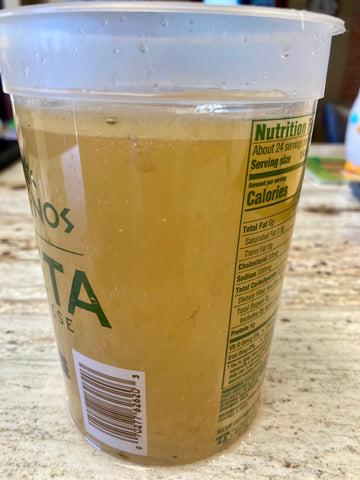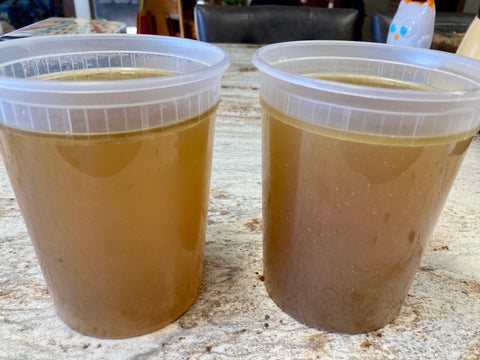Do you make your own homemade chicken broth? I initially started because I wanted to avoid waste and use every possible bit of the whole pastured chickens we had started raising on our farm.
What I didn't expect was how much homemade broth would improve the flavor of our food. It is so delicious and truly adds so much to soups, stews, sauces, crockpot meals, rice dishes, and more.
Pastured chicken broth is also nourishing and nutrient-dense, packed with collagen and minerals. In my reading, people talk about benefits for cognitive function, digestive health, reducing inflammation, recovering from illness, and more. For all these reasons, we are totally hooked on homemade broth now!
This winter, I worked my way through five different options for making chicken broth: leftover chicken bones; a whole chicken; chicken necks; stew hens; and chicken feet. I'm excited to share a few tips for how to make broth at home with each.
Tips for making chicken broth
With any chicken broth, it's good to add something acidic, like wine or vinegar, to facilitate the release of minerals from the bones. A little dry white wine adds nice flavor to chicken broths.
Many recipes call for adding vegetables and spices to your broths. This can be tasty, but my very favorite way to make broth is by just adding water and a little something acidic. That way, the broth can be used for any dish later. If you do want to add veggies, note that they may add overly strong or bitter flavors to your broth, especially if simmered for too long, so don't add them until late in the process, and generally avoid brassicas (like cabbage and brussel sprouts).
Many recipes recommend skimming off any "scum" that floats to the top of your broth during simmering. This "scum" doesn't hurt anything, but if you take it off, you will get a cleaner broth.
After making broth, strain the liquid through a fine-mesh sieve into the jars or containers of your choosing. If you plan to freeze your broth, it will expand at the top, so leave yourself some extra space (especially if using glass--you don't want it to shatter!).
How to make broth: 5 options
1) SPENT CHICKEN BONES
--How to make it: I save leftover bones in a bag in the freezer until I'm ready to make broth or put them straight in a crockpot after we have a whole chicken. If I spatchcock a chicken, I will save the raw back bone, too.
Fill a crockpot or stock pot most of the way with water and add 1/4 - 1/2 cup white wine or vinegar. Cook on low in the crockpot or, if on the stove, bring to a boil then reduce to a simmer and cover. Cook for at least a few hours and up to 18 - 24 hours. Longer times will give the broth more flavor and extract more minerals from the bones.
--Flavor: This broth is typically clear, light, and very versatile, especially good when you're looking for a more neutral flavor.
2) WHOLE CHICKEN
--How to make it: Put a whole chicken in the crockpot or in a stock pot on the stove and cover with water. Cook on low in the crockpot, or bring to a boil then cover and reduce to a simmer on the stovetop, and cook for 4 - 6 hours.
Remove the chicken from the pot and shred the meat to use in soups, salads, enchiladas, tacos, and more. Strain and store the broth, or use it right away to make chicken soup.
--Flavor: This broth will be richer than one made from spent bones, though still very versatile. Once it cools, you may have a layer of fat harden on top; you can scoop this off to use for other cooking, if you like. I find it adds delicious flavor to chicken dishes if I use a tablespoon or two of this rendering to saute my onions or shallots at the start.
3) CHICKEN NECKS
--How to make it: Add chicken necks to your crockpot or stock pot, fill with water, and add 1/4 - 1/2 cup white wine or vinegar. Cook as above and strain.
--Flavor: A pale, light, tasty broth. This is a super economical way to make a delicious broth for any use.
4) STEW HENS
--How to make it: Put your stew hen in a crockpot or stock pot and fill with water. Add white wine or vinegar and cook low and slow, 8+ hours.
When done, remove the stew hen from the pot and shred the meat to use in soups, enchiladas, or casseroles. Strain and store the broth.
Important tips: Don't roast a stew hen! Stew hens are retired laying hens. Their long lives on pasture mean they have lean meat and strong bones and connective tissue, which is very rich in vitamins and minerals. Roasting or grilling a stew hen will likely give you dry meat, but if you cook them low and slow in a crockpot with water, you'll get a beautiful, nutrient-rich broth and tender meat to enjoy in soups or casseroles.
--Flavor: This broth has a rich, very chicken-y flavor. When I heated ours with some onion, carrots, and celery, my husband said it reminded him of sizzling rice soup. Pastured stew hen broth is very nutrient dense. I love this one for sipping on its own.
5) CHICKEN FEET
--How to make it: If your chicken feet still have yellow membranes, first blanch them by bringing a pot of water to a boil, dropping them in for a few seconds, and then transferring them to an ice bath. This will allow you to easily remove the membranes, which will give you the best flavor. Don't leave them in the boiling water for more than a second or two, or you'll actually make the membranes harder to remove. You will also want to remove the talons for best flavor; use a sharp knife or scissors to cut them off before you start making broth.
Once you've prepared the feet, add them to a stockpot, fill with water, bring to a boil, and then reduce to a simmer and cook them, uncovered, for 8 - 12 hours (you can also put them in a crockpot to simmer). Strain and store your broth. Unlike the other types of broth, you will likely want to discard any fat that rises to the top after cooling, rather than using it for other cooking.
--Flavor: Chicken feet make a fabulous, rich broth, as they are packed with collagen and other nutrients. We found our chicken foot broth thick and almost buttery in flavor, something that would be excellent in rice dishes and other meals that could stand up to a richer flavor.
Another way to use chicken feet is to add just 1-2 at a time in with your spent chicken or whole chicken broth. This will give those broths a collagen boost and make them a bit richer, while still yielding a milder flavor.
What are your tips for making homemade broth? I'd love to hear from you!






